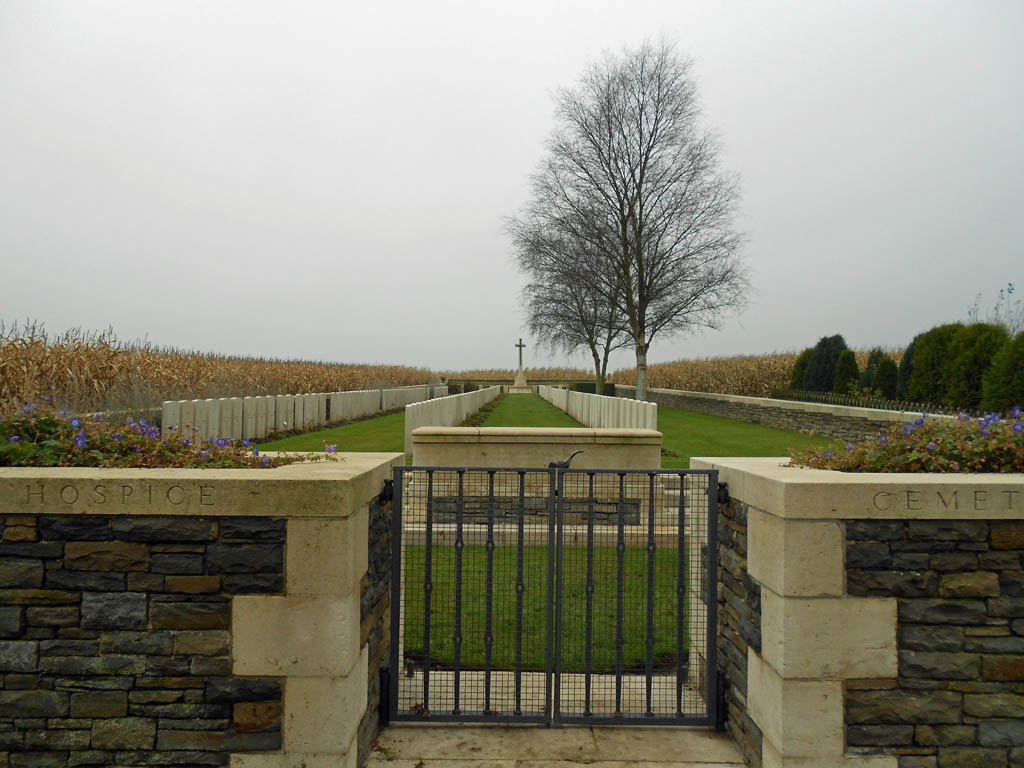Locre Hospice Cemetery
- Country Belgium
- Total identified casualties 248 Find these casualties
- Region West-Vlaanderen
- Identified casualties from First & Second World War
- GPS Coordinates Latitude: 50.77915, Longitude: 2.78082
Location information
Locre Hospice Cemetery is located 10.5 Kms south-west of Ieper town centre on the Godtschalckstraat, a road leading from the Dikkebusseweg (N375).
From Ieper town centre the Dikkebusseweg is reached via Elverdingsestraat, straight over a roundabout onto J.Capronstraat (for 30 metres), then left along M.Fochlaan.
Immediately after the train station, the first right hand turning is the Dikkebusseweg. On reaching the village of Loker (formerly Locre) the first left hand turning leads onto the Kemmelbergweg. There follows an immediate right hand turning onto Godtschalckstraat. The cemetery is located 900 metres along the Godtschalckstraat on the right hand side of the road.
Visiting information
LOCRE HOSPICE CEMETERY & LOCRE ISOLATED GRAVE
ARRIVAL
The cemetery is situated in agricultural land and is signposted, off of Godtschalckstraat.
PARKING
There is space for 1 vehicle to park at the side of the road in a small layby. The parking space is at the junction where a grass track leads to the main entrance of the cemetery from the main road.
The parking area is flat, the ground surface is compacted gravel and earth.
ACCESS LAYOUT AND MAIN ENTRANCE
The cemetery is long and rectangular and 50 metres from the main road, at the end of a grass (hedged on one side) track.
The main entrance has a mid-level (thigh height) black metal gate with an up and down latch on the top of the gate. There are 2 sides to the gate. Both open inwards, providing an entrance gap of 120 centimetres. The left side of the gate is opened by lifting a vertical latch at the bottom of the gate. There is stone paving under the gate at the entrance, which is level with the grass on either side.
From the main gate, there are 4 stone steps on either side of an engraved stone bench. These lead up to the burial area, raised up from the entrance area. The steps narrow in width as they go up to the burial area. There is a narrow dirt strip between the grass and the first step.
There is stone bench seating built into the steps at the entrance to the cemetery. There is no back to the bench and drops off approximately 600 mm down to the bottom step.
The Cross of Sacrifice is at the far end of the cemetery, the furthest point from the main entrance.
The Register Box is mounted into the wall inside the cemetery on the right-hand side at the main entrance, viewed from inside the cemetery.
ALTERNATIVE ACCESS
There are no alternative entrances into the cemetery.
ADDITIONAL INFORMATION
Approximately 20 metres behind the cemetery is the isolated grave of Major William Hoey Kearney Redmond (Locre Isolated Grave). This grave is accessed by following a grass track to the right of the entrance along the boundary wall. At the end of the wall, the track carries on another 20 metres to the grave, surrounded by farmland.
History information
Locre (now Loker) was in Allied hands during the greater part of the war, and field ambulances were stationed in the Convent of St. Antoine. The village changed hands several times between 25 and 30 April 1918, when it was recaptured by the French. The hospice, or convent, was the scene of severe fighting on 20 May, but was not retaken until first week in July.
The Hospice Cemetery was begun in June 1917 by field ambulances and fighting units, and was used until April 1918. After the Armistice four graves were transferred to it from the garden of the Hospice, which was ultimately rebuilt.
The cemetery now contains 244 Commonwealth burials and commemorations of the First World War. 12 of the burials are unidentified and ten graves destroyed by shellfire are now represented by special memorials. The 14 Second World War burials date from late May 1940 and the withdrawal of the British Expeditionary Force to Dunkirk ahead of the German advance. There are also two German burials in the cemetery.
The cemetery was designed by W H Cowlishaw.
A Celtic cross, marking the grave of Major W H K (Willie) Redmond, Member of Parliament for Wexford, stands 100 meters along a grass track on the northern side of the cemetery. Major Redmond was mortally wounded at the battle of Messines and was buried in the Convent garden of the Locre hospice and his widow erected this memorial to mark his grave. Until the late 1950's the grave was maintained by a Sister from the (new) Locre hospice. In the 1990's the land was purchased by the Belgian State and is now maintained by the Commonwealth War Graves Commission.



